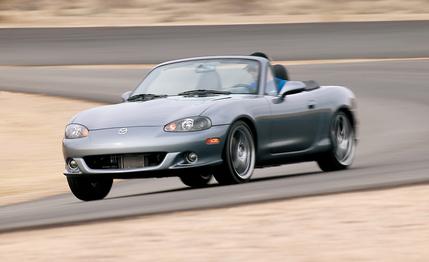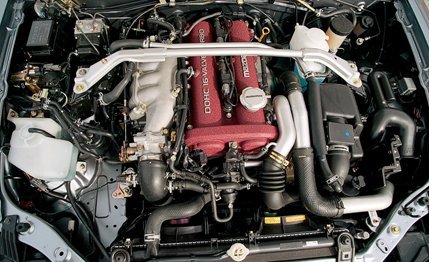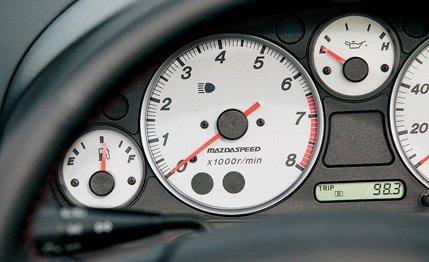 Road Test
Road Test
Perhaps the biggest surprise we got from the new Mazdaspeed MX-5 Miata—other than its remarkable bargain price—is how much of the elemental Miata flavor has been retained. We suspected that a higher-output Miata would require heavier transmission components, a harder ride, and a heavier feel. But the car doesn't manifest any of those characteristics in enough quantity to dilute the essential charm of Mazda's iconic roadster.
From the moment it appeared in 1989, we've been big fans of the little Miata. It made our 10Best list in its original form, and then again when the fixed-headlight version debuted in '98. The Miata was never a powerful car, but it has always been light and nimble—and very entertaining. Evidently, we were not alone in our admiration. From the car's debut until last New Year's Day, Mazda has sold 311,666 Miatas in the U.S.
But here's the best reason ever to buy one: an IHI ball-bearing turbo blowing seven-and-a-quarter pounds of boost into combustion chambers with fractionally reduced compression ratios (9.5 versus 10.0:1). That gives the Mazdaspeed Miata 178 horsepower—36 more than its tamer sibling—to spur it through the quarter-mile in 15.2 seconds. The turbo car has a redline 500 rpm short of the standard model's 7000, but it rips to the red in quick blasts.

We recorded a 6.7-second sprint to 60 mph and expect slightly faster results from production cars. We had to promise to be gentle with the prototype vehicle you see in these pictures, but even so, the car was 1.4 seconds quicker to 60 mph and over a second faster through the quarter than the last Miata we tested.
Mazdaspeed's Miata is based on the normal model's LS trim level and is equipped with the optional six-speed transmission. Beefing up this gearbox for its bigger job involved shot-peening of internal gearwheels along with a fourth-gear ratio change so slight you have to go to three decimal places to appreciate it. The action is thus as light and direct as it has ever been and preserves one of the car's most important entertainment assets.

Gear shifting is critical in a car that gobbles ratios during hard acceleration like a bear in a Burger King Dumpster, and the Miata can be shifted as fast as is humanly possible. But since midrange engine response is stronger in the turbo Miata, too, there is less call for downshifting on the open road. A top-gear 50-to-70-mph time of 7.6 seconds is pretty respectable and four seconds better than the 142-hp model's.

On a purely subjective level, the Mazdaspeed car feels wholly transformed, capable of top-gear traffic slaloms at just a jab of the pedal. The turbo itself is virtually transparent—you can't even hear it with the top up—and it suffers so little lag that the car mostly feels naturally aspirated.
Unlike the Mazdaspeed Protegé, which has a turbo kit supplied by Callaway, Mazda's hot-rod Miata wears a factory-developed and -installed turbocharger kit, as well as a heavier-duty clutch and revised suspension. Both cars are big fun, but we've observed the Protegé's performance to fluctuate from one vehicle to another, hinting at production variations. We doubt this will be a problem with the Miata.
The installation is what you'd expect from a big-name factory: tidy and professional, with neat touches such as induction resonators to cut obnoxious noise. Certainly, the car is endowed with a wonderful sense of integration, offering crisp throttle response and clean transitions even when being shifted violently at the redline.